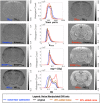Analysis of the effects of noise, DWI sampling, and value of assumed parameters in diffusion MRI models
- PMID: 28090658
- PMCID: PMC6084345
- DOI: 10.1002/mrm.26575
Analysis of the effects of noise, DWI sampling, and value of assumed parameters in diffusion MRI models
Abstract
Purpose: This study was a systematic evaluation across different and prominent diffusion MRI models to better understand the ways in which scalar metrics are influenced by experimental factors, including experimental design (diffusion-weighted imaging [DWI] sampling) and noise.
Methods: Four diffusion MRI models-diffusion tensor imaging (DTI), diffusion kurtosis imaging (DKI), mean apparent propagator MRI (MAP-MRI), and neurite orientation dispersion and density imaging (NODDI)-were evaluated by comparing maps and histogram values of the scalar metrics generated using DWI datasets obtained in fixed mouse brain with different noise levels and DWI sampling complexity. Additionally, models were fit with different input parameters or constraints to examine the consequences of model fitting procedures.
Results: Experimental factors affected all models and metrics to varying degrees. Model complexity influenced sensitivity to DWI sampling and noise, especially for metrics reporting non-Gaussian information. DKI metrics were highly susceptible to noise and experimental design. The influence of fixed parameter selection for the NODDI model was found to be considerable, as was the impact of initial tensor fitting in the MAP-MRI model.
Conclusion: Across DTI, DKI, MAP-MRI, and NODDI, a wide range of dependence on experimental factors was observed that elucidate principles and practical implications for advanced diffusion MRI. Magn Reson Med 78:1767-1780, 2017. © 2017 International Society for Magnetic Resonance in Medicine.
Keywords: DWI sampling; diffusion kurtosis imaging; diffusion tensor imaging; mean apparent propagator MRI; neurite orientation dispersion and density imaging; noise floor bias.
© 2017 International Society for Magnetic Resonance in Medicine.
Figures










References
-
- Pierpaoli C, Jezzard P, Basser PJ, Barnett A, Di Chiro G. Diffusion tensor MR imaging of the human brain. Radiology 1996;201:637–648. - PubMed
-
- Jensen JH, Helpern JA, Ramani A, Lu H, Kaczynski K. Diffusional kurtosis imaging: the quantification of non‐Gaussian water diffusion by means of magnetic resonance imaging. Magn Reson Med 2005;53:1432–1440. - PubMed
-
- Tournier JD, Calamante F, Gadian DG, Connelly A. Direct estimation of the fiber orientation density function from diffusion‐weighted MRI data using spherical deconvolution. NeuroImage 2004;23:1176–1185. - PubMed
Publication types
MeSH terms
Substances
LinkOut - more resources
Full Text Sources
Other Literature Sources

